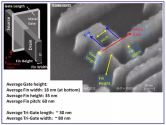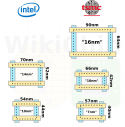8nm ready for mass production and 7nm ready for risk production this April. 5nm still based on latest ASML's DUVL i think.@foofy 7nm Chips mean SMIC N+1 (8nm) ready for mass production this April or N+2 ? risk production using SMEE 28nm DUVL since SMEE EUVL have the same timeline of introduction with 5nm chips?
You are using an out of date browser. It may not display this or other websites correctly.
You should upgrade or use an alternative browser.
You should upgrade or use an alternative browser.
Chinese semiconductor industry
- Thread starter Hendrik_2000
- Start date
- Status
- Not open for further replies.
WoW!!!! @foofy thanks, I mean no disrespect bro but I think ASML latest NXT 2000i DUVL is not allow to be exported to China. So I think the technical difficulties they are facing may pertain to using ASML NXT 1980i or the newly received SMEE 28NM DUVL?8nm ready for mass production and 7nm ready for risk production this April. 5nm still based on latest ASML's DUVL i think.
SMEE 28NM DUVL is impossible.WoW!!!! @foofy thanks, I mean no disrespect bro but I think ASML latest NXT 2000i DUVL is not allow to be exported to China. So I think the technical difficulties they are facing may pertain to using ASML NXT 1980i or the newly received SMEE 28NM DUVL?
ASML DUV machine has no export restriction to China.
ASML will block DUV machine to China especially when China sanction their own parliament and I don't think US and EU will allow it.SMEE 28NM DUVL is impossible.
ASML DUV machine has no export restriction to China.
"The Departments of State and Commerce should work with the governments of the Netherlands and Japan to align the export licensing processes of all three countries regarding high-end SME, particularly EUV and ArF DUV immersion lithography equipment, toward a policy of presumptive denial of licenses for exports of such equipment to China. This would slow China's efforts to domestically produce 7nm or 5nm chips at scale and constrain China's semiconductor production capability of chips at any node at or below 16nm-which the Commission assesses to be most useful for advanced AI applications-by limiting the capability of Chinese firms to repair or replace existing equipment."
For me, just focus R&D on SMEE. US and EU will never allow China to have that technology.
Last edited:
ASML DUV business is viable in China for the next 3 years at most. After this, the Chinese manufacturers will dominate the chinese market and then they will start exporting as well.ASML will block DUV machine to China especially when China sanction their own parliament and I don't think US and EU will allow it.
"The Departments of State and Commerce should work with the governments of the Netherlands and Japan to align the export licensing processes of all three countries regarding high-end SME, particularly EUV and ArF DUV immersion lithography equipment, toward a policy of presumptive denial of licenses for exports of such equipment to China. This would slow China's efforts to domestically produce 7nm or 5nm chips at scale and constrain China's semiconductor production capability of chips at any node at or below 16nm-which the Commission assesses to be most useful for advanced AI applications-by limiting the capability of Chinese firms to repair or replace existing equipment."
And Chinese customers already now that ASML is unreliable, so nobody will bet everything on this company.
Thus if they want to block export then its their loss. China will then realise that the EU is also unreliable on tech, and then you will see China gradually moving away from EU tech.
This is an extremely complex topic so we will see what the final decision will be
@voyager1 bro Blinken had just given the go signal for Europe to deal with China on their owned accord but less so with Russia, Its all optic, Merkel had put EU first before American interest, she and Blinken is part of the Atlanticist and Merkel had major influence inside that group.ASML DUV business is viable in China for the next 3 years at most. After this, the Chinese manufactorers will dominate the chinese market and then they will start exporting as well.
And Chinese customers already now that ASML is unreliable, so nobody will bet everything on this company.
Thus if they want to block export then its their loss. China will then realise that the EU is also unreliable on tech, and then you will see China gradually moving away from EU tech.
This is an extremely complex topic so we will see what the final decision will be
I think Havok was probably being very conservative when he mentioned that the first SMEE EUVL would be equivalent to the NXE3100.That's the CIOMP tech demonstrator in 2017 (and the ASML NXE3100 in 2011 (it was stated to have 27-32nm performance by ASML in 2010, but in around 2012 (IIRC), IMEC managed to squeeze 22nm out of it (presumably due to photoresists or some sort of other optimization). Then again, CIOMP stated that their tech demonstrator fulfilled the 22-32nm EUVL requirement for a Five Year Plan.
The resolution of the EUVL is determined mainly by the Source Power of the Light Source.
The CIOMP Tech Demonstrator and the NXE3100 both used a LPP Light Source with source power of 10W.
ASML then produced upgrades to the Light Source
NXE3300 40W-80W
NXE3350 120W-150W
NXE3400 200W
No one knows the current source power of the LPP Light Source being developed by Shanghai Inst of Optics. Its pretty certain to be higher than 10W.
But the DPP Light Source developed by Harbin Inst produces 150W+.
A EUVL that uses the DPP Light Source of 150W+ would mean something falling in between the NXE3350 and NXE3400.
I think Havok was probably being very conservative when he mentioned that the first SMEE EUVL would be equivalent to the NXE3100.
The resolution of the EUVL is determined mainly by the Source Power of the Light Source.
The CIOMP Tech Demonstrator and the NXE3100 both used a LPP Light Source with source power of 10W.
ASML then produced upgrades to the Light Source
NXE3300 40W-80W
NXE3350 120W-150W
NXE3400 200W
No one knows the current source power of the LPP Light Source being developed by Shanghai Inst of Optics. Its pretty certain to be higher than 10W.
But the DPP Light Source developed by Harbin Inst produces 150W+.
A EUVL that uses the DPP Light Source of 150W+ would mean something falling in between the NXE3350 and NXE3400.
2010: NXE 3100 10W
2013: NXE 3300 40W-80W
2015: NXE 3350 120W-150W
2017: NXE 3400B 200W
2019: NXE 3400C 200W (same as previous version)
If you look at the power of the EUV light source, it appears that ASML has paused power increases or hit a practical limit of 200W.
Last edited:
Because all the nanometer talk is marketing. I am saying this as a programmer in the ASIC design automation industry. What's important is transistor density per mm^2 and 6T SRAM cell size. And even those are not the full story because there are a lot more factors to transistor performance than size. SMIC claims a transistor density of 30 MTr/mm^2 which is actually higher than TSMC 12 nm.This is not true. Smic has not yet achieve 7nm. Even their 14nm chips has lower performance compared to samsung and TSMC 14nm.
Let's have a look at Intel "14 nm" for example:

There is nothing 14 nm here.
Here is TSMC "7 nm" and some other processes:

- Status
- Not open for further replies.
